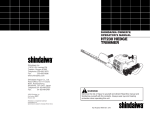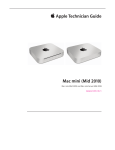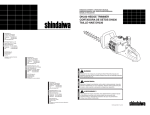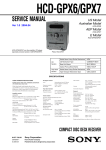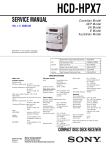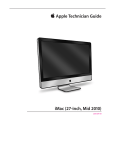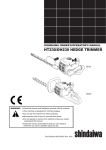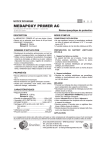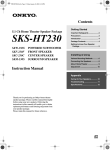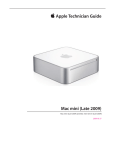Download RedMax HT2301 Service manual
Transcript
SHINDAIWA SERVICE MANUAL SERVICE MANUAL GEARCASE AND CUTTERS Shindaiwa HT230 and DH230 Hedge Trimmers HT230 DH230 DH2301 WARNING! The engine exhaust from this product contains chemicals known to the State of California to cause cancer, birth defects or other reproductive harm. Service Manual Shindaiwa HT230 and DH230 Hedge Trimmers Gearcase and Cutters Contents Section page 1 Model Identification/Specifications ....... 3 2 Internal Gearcase Identification ............. 5 3 Theory of Operation ................................ 6 4 Troubleshooting ...................................... 8 5 Powerhead and Cutter Removal .......... 10 6 Gearcase Disassembly/Inspection ...... 12 7 Gearcase Reassembly .......................... 16 8 Cutter Service ........................................ 18 9 Cutter and Gearcase Maintenance ...... 23 10 Appendix Special and Recommended Tools .......... 25 Torque Specifications .............................. 25 Metric Conversions ................................. 26 Attention Statements WARNING! A statement preceded by the triangle Attention Symbol and the word WARNING contains information that should be acted upon to prevent serious bodily injury. CAUTION! A statement preceded by the word CAUTION contains information that should be acted upon to avoid damaging your machine. IMPORTANT! A statement preceded by the word IMPORTANT is one that possesses special significance. 2 䊚 Shindaiwa Inc. 1998 Model Identification Section 1 HT230 Guide Plate Adjustable Shoulder Bolts with Locking Nuts HT2301 Cutters Protector Cover Powerhead Rear Handle and Throttle Assembly HT2302 Hand Guard and Front Handle Assembly Air Cleaner Cover Rear Handle Bracket Guide Bar Gearcase DH230 Adjustable Shoulder Bolts with Locking Nuts DH2301 Cutters Powerhead Hand Guard and Front Handle Assembly Rear Handle and Throttle Assembly Cover DH2302 Air Cleaner Cover Guide Bar Figure 1. Major Component Identification 䊚 Shindaiwa Inc. 1998 3 Section 1 Specifications General Specifications HT230 & DH230 Drive and Cutters Specifications Dimensions (L x W x H) HT230-30 ..................... 990 x 210 x 210 mm HT230-40 ................... 1330 x 210 x 210 mm DH230-24 .................. 1080 x 250 x 210 mm DH230-30 .................. 1220 x 250 x 210 mm HT230 Blade ......... Double-action, single edge Weight; engine and Cutter (less fuel) HT230-30 .................... 5.5 kg (12.2 pounds) HT230-40 .................... 6.0 kg (13.2 pounds) DH230-24 .................. 5.7 kg (12.5 pounds) DH230-30 ................... 5.9 kg (13.9 pounds) DH230 Blade ....... Double-action, double edge Blade Length HT230-30 ......................................... 740 mm HT230-40 ....................................... 1080 mm DH230-24 ........................................ 605 mm DH230-30 ........................................ 745 mm Clutch Type ............. Fully automatic centrifugal clutch, dry type Engine Specifications Gear Type ....................................... Spur gears Engine Model ....................................... SHT230 Gear Reduction ...................................... 1:4.98 Type ..... 2-cycle, horizontal cylinder, air cooled Gear Lubrication ............ Lithium-based grease Bore x Stroke .......................... 32 mm x 28 mm Standard Equipment Displacement ........................................ 22.5 cc Rear handle with integral controls, anti-vibe mountings. Dry Weight ...................... 2.6 kg (5.73 pounds) Max. Output ....... 1.1 hp (0.81 kW) @ 8000 rpm Fuel ................................. Gasoline-oil Mixture– 40:1 with Shindaiwa Premium 2-cycle Engine Oil Front handle with guard. Tool set and blade cover (scabbard). Options Deflector shield (HT230 only) Fuel Tank Cap., (HT230) ..... 0.7 liter/24 ounces Fuel Tank Cap., (DH230) .... 0.6 liter/21 ounces Carburetor ........ Walbro WYJ (diaphragm type) Ignition .... Fully electronic, transistor controlled Spark Plug ................................ Champion CJ8 Air Cleaner ................. Semi-wet type, silenced Starting Method .............................. Recoil type Specifications are subject to change without notice. 4 䊚 Shindaiwa Inc. 1998 Internal Gearcase Identification Section 2 Nomenclature Gearcase Cover Gasket Felt Seal Shielded Bearings Lower Connecting Rod Thrust Washer Lower Guide Plate Pinion Cam Gear Thrust Washer Shielded Bearing Upper Guide Plate Sealed Bearing Upper Connecting Rod Gearcase Grease Fitting HT2329 Clutch Drum Figure 2. Internal Gearcase Components (shown inverted). 䊚 Shindaiwa Inc. 1998 5 Section 3 Theory of Operation Clutch Figure 3 Shoe (swings outward to engage) Crankshaft rotation is transferred to the gearcase through a bonded-shoe centrifugal clutch threaded to the engine crankshaft. Increasing engine rpm causes the clutch shoes to swing outward under centrifugal force, engaging with and turning the clutch drum on the gearcase. Retraction Spring HT2337 Clutch Drum Figure 3. Clutch Operation. Gearcase Figure 4 Clutch drum rotation is transferred directly to the input pinion gear, which is in constant engagement with the cam gear. The pinion-tocam gear combination reduces engine rpm by a ratio of 1:4.98. 1:4.98 Reduction Pinion Gear Cam Gear HT2347 Figure 4. Reduction Gearing. 6 䊚 Shindaiwa Inc. 1998 Clutch Drum Theory of Operation Cutter Drive Figure 5 Each side of the cam gear is fitted with an eccentric lobe, and the two eccentrics are installed 180˚ opposite one another. Each eccentric is also fitted with a connecting rod mounted on roller bearings, allowing cam gear rotation to be converted to a reciprocating action at the opposing or small end of each connecting rod. Connecting rod thrust is in turn controlled by close-tolerances between the cam gear faces and a set of hardened guide plates that surround the small ends of the connecting rods, held between a set of hardened guide plates. Via the connecting rods, cam rotation is converted into reciprocating motion to drive the cutting attachment. Section 3 Lower Guide Plate Lower Connecting Rod Cam Gear Eccentric Lobe Reciprocating Action Upper Connecting Rod HT2348 Upper Guide Plate Figure 5. Cam Gear and Connecting Rods Cutting Attachment Figure 6 The reciprocating end of each connecting rod is bored to mate with a hardened drive stud at the inner end of each of the two parallel cutters, providing true “double action” performance. To allow independent cutter movement, the individual cutters are slot-mounted over special shoulder bolts threaded into a stationary guide bar attached to the gearcase assembly. Cutters are identified as “upper” and “lower”, and are available with appropriate length guide bars to provide cutting swaths of varying widths. Upper Cutter Guide Bar (stationary) Slot Drive Stud Shoulder Bolt Lower Cutter HT230 Shown HT2349 Figure 6. Cutter Drive Operation. 䊚 Shindaiwa Inc. 1998 7 Section 4 Troubleshooting Performance and durability are highly dependent upon cutter condition, adjustment, and lubrication. For a truly “clean” cut, all cutters must be sharp, undistorted, and in otherwise good condition. For consistent cutting action over the length of the cutter, all shoulder bolts must be in good condition and properly adjusted to maintain cutter-to-cutter contact. IMPORTANT! Beyond outright abuse, gearcase life and cutting performance are directly related to both maintenance and adjustment. Problem Possible Cause Remedy Poor cutting performance Shoulder bolts too loose Adjust bolts per Section 8 Cutter teeth dull Sharpen teeth per Section 8 Shoulder bolts loose or worn Adjust or replace per Section 8 Cutters not “tracking” (non-parallel operation) Worn shoulder bolt slots Cutters not moving, or move very slowly (engine revs) Clutch failure Replace clutch shoe assembly Internal gear failure Overhaul gearcase Cutters will not disengage Engine idle set too high. Reset idle speed to 3000 ± 250 rpm Clutch retraction spring is broken Replace clutch assembly Drive stud is broken Replace cutter per Section 8 Connecting rod failure Replace connecting rod: inspect for internal gearcase damage Shoulder bolt(s) adjusted too tight Readjust per Section 8 Internal gearcase damage Inspect/overhaul gearcase Excessive noise from gearcase Gear or connecting rod failure Inspect/overhaul gearcase Grease leaking from gearcase at guide bar Gearcase too full Section 9 Felt seal damaged Replace seal Cover gasket damaged Replace gasket Water in gearcase (possible outside storage) Drain and refill per Section 9 One cutter not moving Cutters/engine revs slow; engine may overheat Gearcase lube has white “milky” appearance 8 䊚 Shindaiwa Inc. 1998 Troubleshooting Tip Damage Section 4 Guide Plate Worn/Damaged Dirt Accumulation Worn Shoulder Bolt Slots HT230 Shown Poor Lubrication Dull or Damaged Cutters HT2301 Shoulder Bolts Worn/Incorrectly Adjusted Low or Contaminated Lubricant Internal Gearcase Wear Figure 7. Common Causes of Cutter or Gearcase Problems 䊚 Shindaiwa Inc. 1998 9 Section 5 Powerhead Removal Powerhead Removal–HT230 IMPORTANT! Service procedures for the HT230 DH230 powerhead are similar to those for the T230 trimmer and are described in Shindaiwa Grass Trimmers, Brushcutters and Lawn Edgers Service Manual, Form 60506. Air Cleaner (removed for clarity) Cable End Throttle Lever CAUTION! Impact-type power tools can damage the hedge trimmer drive assembly. Ignition Wire Connector STEP 1. Disconnect the throttle cable end from the throttle lever on the carburetor (Figure 8). HT2306A STEP 2. Unplug the red ignition wire from the ignition wire connector, and then temporarily remove the gearcase mounting bolt to disconnect the black grounding wire (Figure 8). STEP 3. Remove the three 6 mm x 16 mm gearcase mounting screws, and separate the gearcase assembly from the powerhead (Figure 9). STEP 4. Remove the two 6mm x 35mm rear handle bracket mounting screws, and lift the rear handle assembly from the gearcase (Figure 9). Black Ground Wire Red Ignition Wire Gearcase Mounting Bolt Figure 8. Disconnecting the throttle cable and ignition wiring Powerhead Gearcase Assembly HT2350 Rear Handle Handle Bracket Mounting Screw Gearcase Mounting Screw Handle Bracket Mounting Screw Rear Handle Bracket Gearcase Mounting Screw Figure 9. Removing the Gearcase Assembly and Rear Handle Bracket 10 䊚 Shindaiwa Inc. 1998 Mounting Screw Powerhead Removal Powerhead Removal–DH230 STEP 1. Disconnect the throttle cable end from the throttle lever on the carburetor (Figure 10). Air Cleaner (removed for clarity) Section 5 Cable End Throttle Lever STEP 2. Unplug the red ignition wire from the ignition wire connector (Figure 10). STEP 3. Remove the three 6 mm x 16 mm gearcase mounting screws, and lift off the powerhead assembly from the gearcase (Figure 11). Ignition Wire Connector DH2307A Red Ignition Wire Figure 10. Disconnecting the Throttle Cable. Powerhead DH2306A Rear Handle Assembly Black Ground Wire Gearcase Assembly Gearcase Mounting Screws (3) Figure 11. Removing the Powerhead Assembly from the Gearcase Assembly 䊚 Shindaiwa Inc. 1998 11 Section 6 Gearcase Disassembly Cutter Removal STEP 1. With the gearcase oriented right-side up, remove the cutter support bracket (Figure 12): ■ Remove the two 6mm bracket retaining nuts from where the guide bar studs emerge from the gearcase. ■ Remove the single 6mm nut and washer from the shoulder bolt at the outer end of the holder bracket, and then lift the bracket from over the guide bar studs. STEP 2. Working from the bottom of the gearcase, remove the six 4mm x 15mm gearcase cover screws and then remove the gearcase cover from the gearcase assembly Figure 13). Bracket Retaining Nuts Cutter Support Bracket Cover Screws Washer Gearcase HT2332 HT230 Shown Shoulder Bolt STEP 3. Lift out the felt grease seal. Unscrew the two 6mm x 12mm guide plate retaining screws, and then remove the lower guide plate (Figure 14). STEP 4. Remove and retain the thrust washer from the cam gear (Figure 14). Shoulder Bolt Nut (6mm) Guide Bar Mounting Studs Figure 12. Removing the cutter support bracket. Guide Plate Screws Cover Gasket Felt Grease Seal Lower Guide Plate Thrust Washer Gearcase Cutter Assembly HT2333 Cam Gear HT2351 Figure 13. Removing the gearcase cover. 12 䊚 Shindaiwa Inc. 1998 Figure 14. Grease seal and lower guide plate removal. Gearcase Disassembly Cutter Removal continued STEP 5. Gently lift the lower con-rod from the cam gear. Be extremely careful not to dislodge the roller bearings from the large end of the connecting rod. All 52 bearing rollers must be accounted for! (Figure 15) Mark for Lower reinstallation! Connecting Rod Section 6 Cutters and Guide bar Assembly BEARINGS ARE NOT CAPTIVATE! IMPORTANT! If the connecting rod is to be reused, mark it now for correct orientation on reassembly. STEP 6. Remove the cutters and guide bar as an assembly (Figure 15). Gearcase HT230 Shown HT2330 Figure 15. Removing the upper con-rod and cutters and guide bar assembly. Removing the Clutch Drum and Pinion Shaft Figure 16 STEP 1. Temporarily lock the pinion shaft by placing a 10mm open-end wrench over the two flats at the inboard end of the shaft. Clutch Tool P/N 99909-20230 A shaft or pin may be used to provided added leverage. STEP 2. Insert tool p/n 99909-20230 into the clutch drum bore, and engage the two pins on the tool with the matching holes in the clutch drum. Turn STEP 3. While using a firm grip to hold the clockwise 10 mm wrench, loosen and remove the to remove clutch drum in a clockwise rotation. If necessary, use a heat gun to soften the ThreeBond™ thread adhesive on the clutch drum threads. CAUTION! Do not overheat the clutch drum and pinion shaft. Excessive heat can damage the pinion shaft bearings. STEP 4. Use a plastic or wooden mallet to remove the pinion shaft from the gearcase casting. HT2331 10mm Open-end Wrench Pinion Gear (note flats provided for wrench) Figure 16. Removing the clutch drum. 䊚 Shindaiwa Inc. 1998 13 Section 6 Gearcase Disassembly Removing the Cam Gear and Upper Con-rod Figure 17 STEP 1. Gently lift the cam gear and upper connecting rod from the gearcase. If the connecting rod is to be reused, mark it now for correct orientation on reassembly. STEP 2. Remove the upper connecting rod thrust washer from the gearcase. Cam Gear Upper Connecting Rod (mark for reinstallation) Upper Guide Plate IMPORTANT! Careless handling will dislodge the connecting rod bearings. The connecting rod roller bearings are loose in the connecting rod large end, and are easily lost. STEP 3. Remove the upper guide plate from the gearcase. Thrust Washer HT2352 Bearing Removal Figure 17. Removing the cam gear and upper con-rod IMPORTANT! Gearcase bearing bores can be damaged by improper bearing removal techniques. If a bearing puller must be used, be extremely careful not to “cock” bearings during removal. STEP 1. Use a heat gun or similar appliance to warm the gearcase cover bearing bores to approximately 212˚F (100˚C ), and then remove the two cover bearings by tapping the cover face down sharply against a flat wooden surface (Figure 18). STEP 2. Use a bearing puller equipped with reversible jaws and a slide-hammer to remove the cam bearing and the clutch drum bearing from the gearcase housing (Figure 19). The gearcase should now be completely disassembled Expanding the Bearing Bore Heat Gun HT2335 Cover Tap the cover sharply Wood Block HT2343 Figure 18. Removing gearcase-cover bearings. Puller with Slide Hammer HT2345 Figure 19. Using a bearing puller. 14 䊚 Shindaiwa Inc. 1998 Gearcase Inspection Cleanup and Inspection Figure 20 Prior to inspection, use a solvent bath to thoroughly clean all components except the connecting rods, and then wipe or blow dry with compressed air. Connecting rods can also be cleaned with solvent, provided that all big-end bearing rollers (52 rollers per connecting rod) are accounted for after cleaning. 1. Inspect the gearcase housing and cover castings for obvious cracks, distortion, or damage to the bearing bores or cover sealing flanges, and discard if noted. Check the gearcase casting for stripped or otherwise damaged threaded areas, and discard if unrepairable. Section 6 found. Be especially alert for damage to the threaded end on the pinion gear, and also to any pitting or other damage to the connecting rod drive lobes on the cam gear. 4. Inspect the clutch drum for cracks, distortion, or damage to the hub area, and replace if noted. 5. Use a strong lens to inspect the connecting rod roller bearings for damage such as chipping or pitting. Inspect the connecting rod small-end bore for damage or out-ofround; and the sides for signs of excessive friction. Any damage or excessive wear to either the connecting rod or roller bearings requires connecting rod replacement as a complete assembly. 2. Visually inspect all bearings for physical damage, especially to protective covers on sealed or shielded bearings, and discard if found. Spin all bearings by hand, and discard any bearing that feels rough, loose, or is otherwise difficult to spin. 6. Inspect the working surfaces of both guide plates, and replace if any damage or measurable wear is noted. 3. Examine both the pinion and cam gears for excessive wear or obvious damage such as chipped or missing teeth, and replace if Cutter inspection is described in Section 8, Cutters. Cover or housing damaged 1 Guide plate scoring 6 Worn or damaged bearings 2 Connecting rod wear 5 Clutch drum threads damaged 4 HT2329B 3 Gear teeth damaged or missing/wear or pitting to the cam lobe Figure 20. Inspecting gearcase components. 䊚 Shindaiwa Inc. 1998 15 Section 7 Gearcase Reassembly Reassembly Reassembly is basically the reverse of assembly, with the additions or exceptions as noted below. Note also that torque specifications have been listed for several key areas. CAUTION! The hedge trimmer can be damaged by overtightening of fasteners. For a complete listing of recommended torque specifications, see the Appendix. Bearing Bearing Installations (Figure 21) Shindaiwa recommends expanding each bearing bore with a heat gun or other appliance set to preheat the bore to approx. 100˚C (212˚F). Individual bearings can then be easily positioned by hand without the risk of damage to the bearing bore. Note that hammering or pounding bearings in place can damage both bearings and bearing bores, and is not recommended. Heat Gun HT2335A Figure 21. Bearing Installation. Lower Thrust Washer Lower Connecting Rod All rollers aligned. Bearing count: 52 Connecting Rods (Figure 22) ■ During connecting rod installation, be extremely careful not to dislodge the individual rollers from their bearing races. Cam Gear ■ If the original connecting rods are being reused, be sure to reinstall each connecting rod in the same location and orientation as removed. ■ Install the upper and lower thrust washers in the reverse order of removal. HT2336 Upper Connecting Rod HT2348A Guide Bar Install the guide bar assembly in the reverse order of removal, and firmly tighten all fasteners. If a torque wrench is available, torque both of the guide bar mounting stud nuts and also the two guide plate screws to 50-70kgf-cm. ■ Install a new felt seal p/n 20870-61630 during assembly (Figure 23). Upper Thrust Washer Figure 22. Reinstall connecting rods in original location and orientation. Install new seal p/n 20870-61630 ■ Lubricate and adjust all shoulder bolts as described in Section 9 of this manual. IMPORTANT! The gearcase assembly contains both shielded and sealed bearings! The clutch-side bearing on the pinion shaft must be a sealed-type bearing, or grease may enter the clutch area. 16 䊚 Shindaiwa Inc. 1998 Sealed Bearing Shielded Bearing HT2342 Figure 23. Install a new felt grease seal. Gearcase Reassembly Reassembly Procedures Clutch Drum Installation STEP 2. Temporarily lock the pinion shaft by placing a 10mm open-end wrench over the two flats at the inboard end of the shaft. STEP 4. If a torque wrench is available, finaltighten the clutch drum to 170-190kgf-cm. HT2346 Figure 24. Applying thread adhesive to the pinion gear threads. Torque Drum to 170-190kgf-cm Clutch Tool Lubrication and Inspection (Figure 26) Prior to gearcase cover installation, hand-pack the gearcase to approx. 50-70% capacity with Shindaiwa p/n 37-57 Gearcase Lube or equivalent high quality lithium-based grease (see Section 9). Install the gearcase cover, and rotate the clutch drum by hand to check for internal binding. If noted, any binding or other such problems must be corrected before the gearcase can be returned to service. 7 ThreeBond™ p/n 13-60 STEP 1. Apply several drops of ThreeBond™ p/n 13-60 thread adhesive to the pinion gear threads, and then install the clutch drum in a counter-clockwise rotation (Figure 24). STEP 3. Use tool p/n 99909-20230 to tighten the drum firmly on the shaft (Figure 25). Section 10mm Open End Wrench HT2341 Installation and Adjustments ■ Install the gearcase and rear handle on the powerhead in the reverse order of removal, and firmly tighten the three gearcase-topowerhead mounting screws. If a torque wrench is available, final-tighten the gearcase mounting screws to 70-100 kgf-cm. ■ Confirm correct throttle cable adjustment by measuring throttle lever “free-play” of 0.010-0.020”. If necessary, turn the cable adjustment fitting on the carburetor in or out until throttle free-play is within the above specifications. HT2331 Figure 25. Tightening the clutch drum. Approximate Capacity: 40-50 grams (1.6 oz.) HT230 Shown Grease Gun HT2333A Figure 26. Lubricating the gearcase. 䊚 Shindaiwa Inc. 1998 17 Section 8 Cutter Service Cutter Disassembly– HT230 Remove the cutter assembly from the gearcase as described in Section 5. Flange Nut Removing the Front Handle STEP 1. Remove the 6mm nut and washer from the hand guard stud, remove the shoulder-bolt nut and washer, and then lift the hand guard assembly from the guide bar (Figure 27). STEP 2. If the hand grip is to be replaced, use a sharp knife to cut the grip lengthwise before peeling it from the guard. 5 mm Stud STEP 3. Remove the two protector mounting screws and washers, and then lift the protector from the guide bar (Figure 28). HT2344 Shoulder Bolt Removing the Guide Plate (Figure 29) Cut off the hand grip to remove. STEP 1. Remove the 5 mm x 8 mm screw at the outboard end of the guide plate. HT2344A STEP 2. Working at the inboard end of the guide plate, remove the shoulder bolt lock nut and then unscrew and remove the shoulder bolt. STEP 3. Slide the guide plate from the end of the cutter assembly. Figure 27. Removing the Front Handle and Shield. Guide Plate Protector Screw Removing the Cutters (Figure 30) STEP 1. Loosen and remove each of the remaining shoulder bolt lock nuts. STEP 2. Unscrew all remaining shoulder bolts from the guide bar, and remove the single flat washer from beneath each shoulder bolt head. Note the use and location of three different shoulder bolt lengths on the HT230. The cutter assembly should now be completely disassembled. HT2353 Guide Plate Shoulder Bolt Figure 28. Removing the Protector. HT2354 Figure 29. Removing the Guide Plate. Locking Nut HT2355 Guide Bar Washer Mounting Studs Shoulder Bolt Shoulder Bolt Slot Upper Cutter Figure 30. HT230 Cutters and Guide Bar Lower Cutter 18 䊚 Shindaiwa Inc. 1998 Cutter Service Cutter Disassembly– HT230 Remove the cutter assembly from the gearcase as described in Section 5. Section 8 6 mm x 35 mm Capscrews Removing the Front Handle STEP 1. Remove the two 6 mm x 35 mm socket head capscrews securing the front handle (Figure 31). STEP 2. Remove the front handle. Removing the Cutters (Figure 32) STEP 1. Loosen and remove each of the shoulder bolt lock nuts. STEP 2. Unscrew all shoulder bolts from the guide bar, and remove the single flat washer from beneath each shoulder bolt head (Figure 32). The cutter assembly should now be completely disassembled. DH2306B Figure 31. Removing the Front Handle and Shield. Locking Nut Guide Bar Mounting Studs Washer Upper Cutter Shoulder Bolt Slot Washer Lower Cutter Shoulder Bolt Figure 32. DH230 Cutters and Guide Bar 䊚 Shindaiwa Inc. 1998 19 Section 8 Cutter Service Inspecting the Cutter and Guide Bar Figure 33 STEP 1. Check the drive pin at the inboard end of each cutter. A loose, missing, or otherwise damaged drive pin cannot be repaired. Where noted, such damage requires cutter replacement. ■ Damaged drive pins are most often the result of allowing the moving blade tips to impact against a wall or sidewalk during operation, but can also be caused by incorrect shoulder bolt adjustment. STEP 2. Visually inspect the blade slots for signs of damage or unusual wear, and then test-fit a new shoulder bolt in each slot. Any of the following are cause for rejecting a cutter: ■ Slot sides are irregular (nonparallel), indicating operation with worn shoulder bolts. STEP 4. Inspect individual cutter teeth for signs of damage, distortion, or unusual wear. Any cutter showing wear or damage such that repairs would require significant reshaping of the cutter is cause for rejection. STEP 5. Examine the shoulder bolts, and reject any bolt with visible body wear or damage to its head or threaded areas. IMPORTANT! Cutter performance and service life are directly related to shoulder bolt lubrication and adjustment. STEP 6. Visually inspect the guide bar for damage, unusual wear, or distortion. Any of the following are cause for rejection: ■ Galling between blade and shoulder bolt head. Usually indicates poor lubrication, possibly combined with overtightening shoulder bolts. ■ Bending or twisting (check against straightedge). ■ Loss of blade thickness; blade slot appears "dished" when viewed from edge. Indicates poor lubrication, dirty operating conditions. ■ Stripped or otherwise damaged shoulder bolt mounting threads. STEP 3. Visually inspect the inner working surfaces of the guide plate. If evidence of galling or grooving are noted, the plate must be replaced. Check for damaged drive pins ■ Damage to the mounting stud shanks or threads. STEP 7. Inspect the front hand grip and guard assembly. The rubber hand grip can be serviced as a separate part number; damage to the guard requires replacing both components as an assembly. Check for damaged cutter teeth HT2340 HT230 Shown Check for damaged shoulder bolts Check for damaged or worn slots Figure 33. Inspecting the cutter and guide bar (shown inverted). 20 䊚 Shindaiwa Inc. 1998 "Dished" appearance Cutter Service Reassembling the Cutter and Guide Bar– HT230 Figure 34 Section 8 STEP 2. Install the front handle assembly over its mounting stud and shoulder bolt. IMPORTANT! Unless the cutters are being replaced with new or reconditioned components, all cutting teeth should be sharpened before reassembly. For recommended sharpening procedures, please see Section 9. ■ Install a flat washer and nut over the front handle mounting stud, and tighten the nut securely. ■ Install a flat washer and a new shoulder bolt locknut over the shoulder bolt at the hand grip, but do not tighten the nut at this time. WARNING! STEP 3. Install the protector and holder support bracket over the innermost shoulder bolt, and loosely secure the assembly with a spring washer and shoulder bolt locknut. Install and firmly tighten the 5 mm x 8 mm screw through the remaining protector mounting hole. Incorrect assembly could expose the operator to serious injury! Read and follow assembly instructions carefully! STEP 1. Lightly lubricate both the cutters and the guide bar with clean oil, and then assemble all three components as shown. Install–but do not tighten–a flat washer and the appropriate length shoulder bolt in each guide bar slot except the slot beneath the guide plate. The 6 mm x 20 mm guide plate shoulder bolt should now be loosely installed, but without a washer. Finally, install and firmly tighten the 5 x 8mm hex bolt through the remaining hole in the guide plate. STEP 4. Loosely install a new locknut over each of the remaining shoulder bolts. STEP 5. Install the guide bar and cutter assembly on the hedge trimmer in the reverse order of removal. STEP 6. Adjust all shoulder bolts as described in Section 9, “Gearcase and Cutter Maintenance”. Install the front handle Hand Guard 2 Hand Grip Cutter Support Bracket Lubricate and assemble cutters and guide bar Guide Bar 6 x 8mm Install the guide plate 5 1 Install new 4 locknuts Install the 3 protector and cutter support bracket Protector 6 x 20mm 6 Washer HT2328 Shoulder Bolt 6 x 32mm Lower Cutter Upper Cutter 6 x 20mm Adjust all shoulder bolts 6 x 25mm Figure 34. Reassembling the HT230 Cutter and Guide Bar. 䊚 Shindaiwa Inc. 1998 21 Section 8 Cutter Service Reassembling the Cutter and Guide Bar– HT230 Figure 34 STEP 2. Install the holder support bracket over the innermost shoulder bolt, and loosely secure the assembly with a spring washer and shoulder bolt locknut. IMPORTANT! Unless the cutters are being replaced with new or reconditioned components, all cutting teeth should be sharpened before reassembly. For recommended sharpening procedures, please see Section 9. STEP 3. Loosely install a new locknut over each of the remaining shoulder bolts. STEP 4. Install the guide bar and cutter assembly on the hedge trimmer in the reverse order of removal. WARNING! STEP 5. Adjust all shoulder bolts as described in Section 9, “Gearcase and Cutter Maintenance”. Incorrect assembly could expose the operator to serious injury! Read and follow assembly instructions carefully! STEP 1. Lightly lubricate both the cutters and the guide bar with clean oil, and then assemble all three components as shown. Install–but do not tighten–a flat washer and the appropriate length shoulder bolt in each guide bar slots. Lubricate and assemble cutters and guide bar Guide Bar Install new 3 locknuts 1 Upper Cutter Cutter Support Bracket 4 Install cutter assembly onto hedge trimmer 6 mm x 20 mm 5 Adjust all shoulder bolts 2 Install the cutter support bracket HT2361 Figure 35. Reassembling the DH230 Cutter and Guide Bar. 22 䊚 Shindaiwa Inc. 1998 Lower Cutter Cutter and Gearcase Maintenance Sharpening the Cutters Figure 36 A sharp and properly adjusted cutting assembly should produce a clean, chisel-like cut. A dull or improperly adjusted assembly tends to produce a rougher, shredding-type cut, and also places additional demands on both the operator and the machine. Frequent touch-up of the cutter edges can be accomplished without disassembling the machine, and requires the use of grinding stones to dress the cutter edges as described in Steps 3 and 4 (below). Where one or more cutter teeth have suffered repairable damage, however, Shindaiwa recommends the following procedure for resharpening the cutter assembly: 35° Section 9 20° 90° 45° 43° HT2358 HT230 ONLY DH230 ONLY Figure 36. Sharpening angles. STEP 1. Remove the guide bar and cutter assembly from the trimmer (Section 5). STEP 2. Remove the upper and lower cutters from the guide bar (Section 8). Repair or replace any worn or damaged components as described in “Cutter and Guide Bar Inspection.” STEP 3. Use a rough grinding stone held at the angle shown (45°, HT230; 43°, DH230) to remove damage and restore the original bevel to the cutter edges. Use care to maintain the original shape and angle of the cutter teeth (Figure 37). HT230: 45° DH230: 43° HT2356 Figure 37. Grinding and sharpening the cutter bevels. STEP 4. HT230 ONLY. Use a rough grinding stone held at a 35° angle to restore the original bevel to the cutter tips (Figure 38). HT230 ONLY STEP 5. Use a fine oil stone to smooth the edges produced in Steps 3 and 4. STEP 6. Turn the cutter over, and use a fine oil stone held flat to remove any burrs from the bottom faces of the individual cutter teeth (Figure 39). STEP 7. Lightly oil the upper cutters and guide bar. Reassemble the guide bar and cutters (Section 8), but do not tighten the shoulder bolts or locknuts at this time. 35° HT2357 Figure 38. Beveling the cutter tips. STEP 8. Reinstall the cutter assembly on the hedge trimmer (Section 5). Back of blade HT2359 Stone flat against the blade Figure 39. Removing burrs. 䊚 Shindaiwa Inc. 1998 23 Section 9 Cutter and Gearcase Maintenance Shoulder Bolt Adjustment STEP 1. Loosen all shoulder bolt locknuts (at least one full turn each). Figure 40 STEP 2. Tighten all shoulder bolts firmly, and then loosen each shoulder bolt approximately 1/4-1/2 turn. Locknut STEP 3. Working from the powerhead, lock each shoulder bolt in place by firmly tightening its locknut while preventing the shoulder bolt from turning. STEP 4. Shoulder bolt adjustment is correct when there is (approximately) a 0.025– 0.050mm gap between the cutter faces and the shoulder bolt washer can be freely rotated by hand. Daily Cutter Maintenance Figure 41 Guide Bar Cutters HT2321 Shoulder Bolt Washer should turn freely Figure 40. Adjusting Shoulder Bolts. Lubricate Cutters HT230 SHOWN Daily Maintenance (cutters only) A dull or poorly adjusted cutting assembly requires additional operator effort, and places additional demands on the hedge trimmer gearcase and powerhead. For maximum cutter performance and service life: Check and Adjust Shoulder Bolts Daily STEP 1. Adjust shoulder bolts daily, and replace when visible wear is detected. HT2317 STEP 2. Lubricate cutters and guide bar frequently during operation. Figure 41. Lubricating the Cutters and Guide Bar. ■ Clean 30-weight oil is recommended ■ Some biodegradable oils can help reduce “brownout” caused by excess lubricant on delicate shrubbery. Gearcase Maintenance Grease Gun Every 20 Operating Hours (Figure 42) ■ Top off gearcase grease level by using a lever-type grease gun to force 1-2 strokes of high quality lithium-based grease through the gearcase grease fitting. Every 100 operating hours/before longterm storage (Figure 43) HT230 SHOWN HT2322A Figure 42. Adding Grease with a Grease Gun. STEP 1. Remove the gearcase cover, and use solvent and a soft brush to remove all old grease from the gearcase. STEP 2. Hand-pack the gearcase with approx. 40-50 grams (about 1.6 oz.) of high quality lithium-based grease to about 50-70% of capacity. DO NOT OVERFILL! IMPORTANT! Over-lubrication could cause the gearcase to run slower (and hotter) than normal. In addition, over-lubrication could cause excess grease to leak past the felt seal in the gearcase. HT2323 HT230 SHOWN Hand-pack gearcase to 50-70% capacity Figure 43. Hand-packing the gearcase. 24 䊚 Shindaiwa Inc. 1998 Appendix Section 10 Special and Recommended Tools CYL-56 HT2346A Clutch Drum Spanner p/n 9990920230 Piston Stop (nylon) p/n 22155-96240 Puller Assembly p/n 20000-96104 T-Wrench (allen type) p/n 22155-96521 (3mm) p/n 22155-96531 (4mm) p/n 22155-96540 (5mm) ThreeBond™ Thread Sealant p/n 13-60 Figure 44. Special tools recommended for servicing the Shindaiwa HT230 and DH230 Hedge Trimmer. Torque Values 50-70 70-100 kgf-cm kgf-cm 70-100 kgf-cm 70-100 kgf-cm 40-50 kgf-cm HT2328 HT230 DH230 50-70 kgf-cm Adhesive p/n 13-60 HT2350 DH2306A 90-120 kgf-cm 70-100 kgf-cm 90-120 kgf-cm 170-190 kgf-cm 70-100 kgf-cm HT2329C Figure 45. Shindaiwa Hedge Trimmer Torque Values. 䊚 Shindaiwa Inc. 1998 25 Section 10 Appendix Metric Conversions Length 1 in. = 25.4 mm 1 mm = .03937 in. 1 in. = 2.54 cm 1 cm = .3937 in. 1 ft. = 30.48 cm 1 cm = .0328 ft. 1 ft. = .304 meter 1 meter = 3.28 ft. 1 mile = 1.609 km 1 km = .621 mile 1 cu. in. = 16.39 cc 1 cc = .061 cu. in. 1 cu. in. = .061 liter 1 liter = 61.02 cu. in. 1 fl. oz. = 29.574 ml 1 ml = .0338 fl. oz. 1 fl. oz. = .02957 liter 1 liter = 33.81 fl. oz. 1 gal. = 3.785 liter 1 liter = .264 gal. 1 oz. = 28.35 gm 1 gm = .0353 oz. 1 lb. = .4536 kg 1 kg = 2.2 lb. 1 in. lb. = 1.152 kg/cm 1 kg/cm = .868 in. lb. 1 in. lb. = .112 n/m 1 n/m = 8.844 lb. 1 ft. lb. = .138 kg/m 1 kg/m = 7.23 ft. lb. 1 ft. lb. = 1.36 n/m 1 n/m = .737 ft. lb. 1 hp (SAE) = .746 kw 1 kw = 1.34 hp (SAE) 1 hp (SAE) = .9861 hp (DIN) 1 hp (DIN) = 1.104 hp (SAE) 1 hp (SAE) = 1.017 psi 1 psi = .9836 hp (SAE) 1 psi = .0689 bar 1 bar = 14.5 psi 1 psi = 6.89 kpa 1 kpa = .145 psi 1 psi = .07031 kg/sq cm 1 kg/sq cm = 14.22 psi Temperature °F to °C = Temperature in F - 32 x 5/9 (.555) °C to °F = Temperature in C x 9/5 (1.8) + 32 Miscellaneous 1 mph = 1.6 km/hr 1 km/hr = .625 mph 1 mpg = .425 km/liter 1 km/liter = 2.35 mpg Volume Weight Force Power Pressure 26 䊚 Shindaiwa Inc. 1998 Notes 䊚 Shindaiwa Inc. 1998 27 1998 Shindaiwa Inc. Form No. 61305-1 Printed in U.S.A. Shindaiwa is a registered trademark of Shindaiwa Inc. SHINDAIWA SERVICE MANUAL Shindaiwa Inc. 11975 SW Herman Road P.O. Box 1090 Tualatin, OR 97062 Phone 503 692-3070 FAX 503 692-6696 www.shindaiwa.com





























